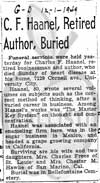Biography and Genealogy of Charles F. Haanel
Table of Contents: Introduction • Charles Francis Haanel (May 22, 1866 – November 27, 1949) • Work and Business Experience• Enter the Master Key System • Complaints and Political Intrigue? • Books After The Master Key System • Haanel’s Final Years • The Final Analysis? • History of the Haanel and Fox Families and Other Family Members • Footnotes • Sources
Charles Francis Haanel and the Haanel Family
Introduction
Most biographies on Charles F. Haanel, author of The Master Key System, are based on one article from Walter B. Stevens’ St. Louis – History of the Fourth City (1909), and most biographies of the man contain mistakes, misinterpretations, or down-right lies. For example, the belief that Haanel’s books were banned in 1933 and that his publication disappeared from the market is a fabrication. Not only is there no record of a banning (by anyone, including the Roman Catholic Church) in 1933, but it can be shown that he was still advertising, publishing, and printing The Master Key System in 1935.
Researching and compiling this biography of Charles F. Haanel has been a monumental task. The research was often beset not only by the factor of the length of time that has passed, but also by the fact that not much was written about Haanel. Thus, source documents were scarce and the data that has been compiled was done so by “connecting the dots” rather than by direct associations.
This biography is the most thorough available about him. His family history was discovered as well as many of his business interests.
While this biography will illuminate Haanel’s influences, his business dealings, and even some portions of his family life, it cannot tell you what were his motives for writing his books. It also cannot tell you what Haanel really was like as a man. It is hoped, though, that this biography will give the reader some insight into the man who has in the present day become more known through rumor and innuendo rather than facts.
(top)
Charles Francis Haanel (May 22, 1866 – November 27, 1949)
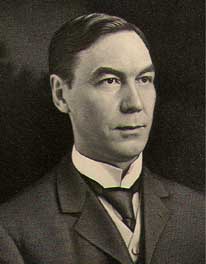 Charles Francis Haanel was born on May 22, 1866 in Ann Arbor, Washtenaw County, Michigan, in the United States of America. (1) He was the first child and son of Hugo Paul Haanel and Emeline Cordelia Fox. The Haanel family soon moved from Michigan to St. Louis, Missouri, when Hugo took a job as a teacher at the Picker School. Following their arrival in St. Louis, the Haanel family grew and seven more children were born after Charles, though only five grew to adulthood. These were Clara C. (February 1872), Julius Bernard (November 1873), Honora I. (November 1875), Alice (January 1878) and Hugo Paul, junior (February 1881). In the 1870s, the Haanels lived at 1012 Wash and then moved to 1131 North 19th, where the family was still living in the 1890s. Later they moved to 3106 School and then 4718 Labadie.
Charles Francis Haanel was born on May 22, 1866 in Ann Arbor, Washtenaw County, Michigan, in the United States of America. (1) He was the first child and son of Hugo Paul Haanel and Emeline Cordelia Fox. The Haanel family soon moved from Michigan to St. Louis, Missouri, when Hugo took a job as a teacher at the Picker School. Following their arrival in St. Louis, the Haanel family grew and seven more children were born after Charles, though only five grew to adulthood. These were Clara C. (February 1872), Julius Bernard (November 1873), Honora I. (November 1875), Alice (January 1878) and Hugo Paul, junior (February 1881). In the 1870s, the Haanels lived at 1012 Wash and then moved to 1131 North 19th, where the family was still living in the 1890s. Later they moved to 3106 School and then 4718 Labadie.
The first census to possibly show the Haanel family is the one for 1870 and they are under the name “Heimell.” They consisted of Hugo (though the initial is given as “C”), aged 35, and wife Emelia (26) with son Charles, aged 4. Hugo is shown as being born in Prussia and Emelia as being born in Wisconsin, while Charles was born in Michigan. They were residing in St. Louis and C. Haanel’s occupation was a retired minister. It is possible that this is a different family, but a St. Louis directory shows that Hugo Haanel was living at 1012 Wash, St. Louis in 1871. He was recorded as being principal of the Picker School. A year later he was principal of the North School of the Church of the Holy Ghost. (Both schools were connected with the Rev. Frederick Picker who was a minister in St. Louis in the 1840s and 1850s.)
(top)
Work and Business Experience
 Charles attended public schools in St. Louis and then got his first full-time job at the National Enameling and Stamping Company as an office boy in 1886. This company had been formed by the Neidringhaus brothers, Frederick and William, from Westphalia, Germany. Charles worked there for 15 years (2) and may have also attended college as the 1885 St. Louis Directory has the abbreviation “coll.” next to his name.
Charles attended public schools in St. Louis and then got his first full-time job at the National Enameling and Stamping Company as an office boy in 1886. This company had been formed by the Neidringhaus brothers, Frederick and William, from Westphalia, Germany. Charles worked there for 15 years (2) and may have also attended college as the 1885 St. Louis Directory has the abbreviation “coll.” next to his name.
During the time Charles worked at the National Enameling and Stamping Company he met Esther Martha Smith. They were married on November 22, 1888. Esther was born in 1866 and was the daughter of Irish parents Samuel and Jane Smith. Their marriage lasted 16 years and they had four children: Jennie, sometimes known as Jane or Jean (September 1889); Esther (January 1892); Walter (April 1894); and Edith (June 1898).
In 1885, Charles went into the publishing business and after buying out his partners, set up the C.F. Haanel Publishing Company with offices at 4723 Greer Avenue. These publishing companies published illustrated magazines such as Illustrated Monthly (later called The Home Circle) until 1896. It is uncertain whether Haanel had this business while employed at the National Enameling and Stamping Company or if he took a leave of absence.
Later, Charles, from the same offices, was first secretary and then president of several companies including the Oaxaca Coffee Culture Company, the Continental Sugar Company, and the Continental Commercial Company. The latter was still trading in 1907, but in 1910 Charles was president of the Sacramento Valley Improvement Company. His brother Julius Bernard, who had worked as a clerk at the National Enameling and Stamping Company and a cashier in the Continental Commercial Company, moved to Sacramento, California, where he was vice president of the Sacramento Valley Improvement Company. (In 1910, Julius had married May (Mae) Robinson and had two children: McKee and Marian.)
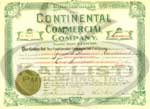 According to Walter B. Stevens, the Continental Commercial Company was one of the largest companies in the world and “capitalized for two million five hundred thousand dollars.” Stevens also wrote about how Haanel, having left the National Enameling and Stamping Company, convinced “a number of capitalists” to purchase land in the vicinity of Tehuantepec, Mexico, for the growing of sugar and coffee. He went on to tell that this was organized in 1898 and the Continental Commercial Company was set up in 1905.
According to Walter B. Stevens, the Continental Commercial Company was one of the largest companies in the world and “capitalized for two million five hundred thousand dollars.” Stevens also wrote about how Haanel, having left the National Enameling and Stamping Company, convinced “a number of capitalists” to purchase land in the vicinity of Tehuantepec, Mexico, for the growing of sugar and coffee. He went on to tell that this was organized in 1898 and the Continental Commercial Company was set up in 1905.
It can be shown that the Continental Commercial Companywas established in August 1905, had offices in the Commonwealth Trust Building, St. Louis, and that its directors were
- Thomas Hennings – President
- C. H. McKee – Vice-president (3)
- J. E. Carnahan
- A. P. Erker
- Chas. W. Owen
The Continental Commercial Company controlled the following companies and plantations:
- The Continental Sugar Refining Co.
- The Oaxaca Coffee Culture Co.
- The Mount Rosa Land and Cattle Co.
- The Iolita Plantation
- The Pittsburgh Plantation Co.
- The Jumiapa Plantation
- The Mount Verde Plantation
![]() It is also recorded that the Company had 18,000 acres of land in Mexico and 1,000,000 coffee trees. (4)
It is also recorded that the Company had 18,000 acres of land in Mexico and 1,000,000 coffee trees. (4)
The Sacramento Valley Improvement Companyseems to have prospered for a while and was described as “controlling the largest Tokay vineyards in the world.” However, the California project seems to have folded after 1911. People purchased two acre parcels of Tokay grapes and ten acre parcels of eucalyptus at $600 and $2,000. There were hundreds of buyers, but the venture was unsuccessful and after a few years the company was dissolved. Julius B. Haanel, who had been vice-president of the company, left California and went to live in Chicago.
Charles Haanel’s wife Esther died on April 18, 1904. The cause of her death remains unknown. Four years later on July 8, 1908 he married Margaret S. Nicholson, daughter of William and Margaret Nicholson. Margaret (who seems to have been known to her family as Pearl) was born October 28, 1882 in St. Louis. By 1920, Charles had two more children: Beverley (1911) and Charles F., Jr. (1914).(5)
(top)
Enter the Master Key System
Sometime after 1911 Charles began to publish The Master Key System in weekly parts. It is unclear why and when Haanel changed from a trading company president into an author. It would seem that the earliest versions of The Master Key System consisted of 24 lessons, which were later bound into book form and published in 1916.
While publishing his correspondence course, Haanel advertised in various magazines and journals. One of these was The Nautilus (published from 1898 to 1953), which was in the forefront of the New Thought Movement and published by William and Elizabeth Towne. Haanel began by offering a free booklet called The Master Key. (This little booklet makes quite interesting reading on its own and the complete text can be found in Kallisti Publishing’sMaster Key Arcana.)
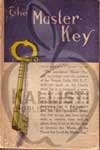 The Master Key was an introduction and a sales pamphlet to Haanel’s The Master Key System, which he said “…teaches the use of Mind Power — true Mind Power — not any of the substitutes and perversions. It has nothing to do with Hypnotism, Magic, or any of the more or less fascinating deceptions by which many have been led to think that something can be had for nothing.” He ended the pamphlet with the penultimate paragraph stating: “The Master key System comes in twenty-four parts, one part is mailed each week. Each part has a series of questions by which your understanding of the lesson is tested…”
The Master Key was an introduction and a sales pamphlet to Haanel’s The Master Key System, which he said “…teaches the use of Mind Power — true Mind Power — not any of the substitutes and perversions. It has nothing to do with Hypnotism, Magic, or any of the more or less fascinating deceptions by which many have been led to think that something can be had for nothing.” He ended the pamphlet with the penultimate paragraph stating: “The Master key System comes in twenty-four parts, one part is mailed each week. Each part has a series of questions by which your understanding of the lesson is tested…”
It is said that The Master Key System began to be published in 1912 but I haven’t been able to find any independent references to this. Directories have Haanel occupying offices 411 at 406 Market in 1915 and running a correspondence school at 709 Pine by 1918. Though web sites and publications often state the year 1912 (and some 1909) I cannot be sure of anything before 1916 when it can be shown that Haanel copyrighted The Master Key System.
The Master Key System in book form was advertised in many different publications. The cloth cover version of the book was $3.60 and the deluxe version $5.40. Now this isn’t a cheap book and would sell today around the same price as the final “door stopper” in the Harry Potter series (hardback and deluxe versions being $34.99 [£17.99] and $65.00 [£35.00] respectively), though with less than half the pages.
(top)
Complaints and Political Intrigue?
Whatever the level of success attained by Haanel’s book, what can be said is that possible complaints can be found in some very interesting places.
Following the 1920 Presidential Elections, a report was made by the United States Congress, Senate Committee on Privileges and Elections. In this there is a specific mention of Haanel. Only a snippet of the discussion was obtainable. Obviously, something interesting to the Committee was published by Haanel. The quote is thus:
“The CHAIRMAN. Charles F. Haanel, 707-709-711 Pine Street, St. Louis, Mo., seems to be the author. You have no knowledge of who would be sending out syndicated articles that appear in the papers concerning the League of Nations?”
The person answering the questions seems to be a Mr. Moore, but that is all that can be ascertained of this enigmatic snippet. It can be found on page 2227 of Presidential Campaign Expenses: Hearing[s] Before a Subcommittee of the Committee on Privileges and Elections (unknown volume), published in Washington, DC, in 1921.
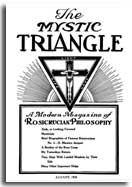 The second mention of Haanel may be more interesting. In The Mystic Triangle, for December 1928, there is an “Important Notice.” It stated that someone was writing letters using AMORC letterhead paper and they seemed to say that AMORC endorsedThe Master Key System. The notice said that members of AMORC were confused by this and that AMORC would look into this. It emphasized that in no way had there been an endorsement of the above mentioned publication.
The second mention of Haanel may be more interesting. In The Mystic Triangle, for December 1928, there is an “Important Notice.” It stated that someone was writing letters using AMORC letterhead paper and they seemed to say that AMORC endorsedThe Master Key System. The notice said that members of AMORC were confused by this and that AMORC would look into this. It emphasized that in no way had there been an endorsement of the above mentioned publication.
AMORC stands for the Ancient Mystical Order Rosae Crucis, an American organization affiliated to the Rosicrucian Order in Europe and found by H. Spencer Lewis in 1915. Their journal from 1925 to 1929 was called The Mystic Triangle.(6)
Finally, in 1927, Haanel was singled out by none other than Upton Sinclair in his The Profits of Religion (1927). In the chapter “New Nonsense,” Mr. Sinclair unleashes a tirade against the New Thought practitioners and focuses on an advertisement in the magazine The Nautilus.
“I look over this Priestess’ [referencing the editor of The Nautilus, Elizabeth Towne] magazine, and find it full of testimonials and advertisements for the conjuring of prosperity. ‘Are you in the success sphere?’ asks one exhorter; the next tells you ‘How to enter the silence. How to manifest what you desire. The secret of advancement.’ Another tells: ‘How a Failure at Sixty Won Sudden Success; From Poverty to $40,000 a year — a Lesson for Old and Young Alike.’ The lesson, it appears, is to pay $3.00 for a book called ‘Power of Will.’ And here is another book:
“Master Key: Which can unlock the Secret Chamber of Success, can throw wide the doors which seem to bar men from the Treasure House of Nature, and bids those enter and partake Who are Wise enough to Understand and broad enough to Weigh the Evidence, firm enough to Follow their Own Judgment and Strong enough to Make the Sacrifice Exacted.”
Nothing more could be found about these references. Did Haanel have intrigue regarding the League of Nations? Did he misappropriate AMORC letterheads? Why was Haanel mentioned in a Congressional committee meeting?
Regarding the Rosicrusians, it is known that Haanel was a member of the Keystone Lodge No. 243, AF & AM, a 32nd degree Mason, and a Shriner – Noble in the Moolah Temple. It has also been stated that he was a member of the Society of Rosicrucians. Haanel was initiated into the Keystone Lodge #243 in Webster Groves, St. Louis, on May 4, 1904 and by July 13th was a Master Mason. He also became a member of the Ancient Arabic Order of the Mystic Shrine on October 29, 1904. Haanel never held office in the Masons and was suspended on November 20, 1935 for non-payment of dues.
(top)
Books After The Master Key System
Following The Master Key System, Haanel wrote several more books of a similar nature. These included:
- The New Psychology (1920)
- Social Science (1922)
- Mental Chemistry (1922)
- A Book About You (1927)
- The Amazing Secrets of the Yogi, with Victor S. Perera (1937)
Several of these books seem to be bound versions of publications of a smaller nature such as Cause and Effect (1922). It is also possible that the latter was an alternative title for one of Haanel’s other books. It is highly likely that Haanel also wrote articles for various magazines and journals, but as of the writing of this article, none have been found.
 Charles F. Haanel’s listing in Who’s Who Among North American Authors 1929-1930. (1) |
 Charles F. Haanel’s listing in Who’s Who Among North American Authors 1929-1930. (2) |
(top)
Haanel’s Final Years
In 1925, the St. Louis Directory had Charles F. Haanel as publisher of “The Master Key” with offices on the 2nd floor of the Lesser Building on 704 9th and residing at 5032 Cabanne. By 1930 he was living at 7129 Cornell Avenue, University City and in 1935 he as a printer with offices at 3847 Washington Boulevard. It would seem that Haanel retired after this and later directories (1941 and 1946) only record his and Margaret’s residence at 7129 Cornell. By this time Haanel’s immediate family had all married or died, as in the cases of Edith and Charles, Jr.
Charles Francis Haanel passed away at 1:15 PM on November 27, 1949, aged 83 years old. His death certificate states the cause of his death was unknown. A private ceremony was held at C. R. Lupton & Sons Funeral Director’s chapel at 10:00 AM on November 30th and he was buried at Bellefontaine Cemetery at 11:00 AM the same day. Margaret Haanel (nee Nicholson) survived her husband by two years and died of a cerebral hemorrhage at the De Paul Hospital on October 2, 1951.
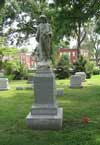 The Haanel and Nicholson families have plots (4646 Block 6 and 4143 Block 29-38) in Bellefontaine Cemetery. Included in the Haanel plot are Charles F., his parents Hugo and Emeline, his daughter Edith Ione, and his first wife Esther. There is also the burial of an unnamed infant child of Charles W and Jane Frees. Near the plot is a monument to Esther and Edith, presumably set up by Charles. In the Nicholson family plot can be found Haanel’s second wife Margaret, her parents, her siblings and, interestingly, Charles F. Haanel junior. Other members of the Haanel family are buried in Chicago.
The Haanel and Nicholson families have plots (4646 Block 6 and 4143 Block 29-38) in Bellefontaine Cemetery. Included in the Haanel plot are Charles F., his parents Hugo and Emeline, his daughter Edith Ione, and his first wife Esther. There is also the burial of an unnamed infant child of Charles W and Jane Frees. Near the plot is a monument to Esther and Edith, presumably set up by Charles. In the Nicholson family plot can be found Haanel’s second wife Margaret, her parents, her siblings and, interestingly, Charles F. Haanel junior. Other members of the Haanel family are buried in Chicago.
From two families with interesting pasts, Haanel must have inherited something from each. Hugo Haanel was both a teacher and author, while Uncle Eugene was a prominent scientist who, on his death, was given a long obituary in The Times of London. The Foxes were farmers descended from pioneers and in one case an inventor. Sister Honora Soward seems to have been a member of the New Thought Movement and was a Christian Science practitioner. However, little else can be found to explain why a businessman with a finger in many pies began to write books of a spiritual and self-improvement nature.
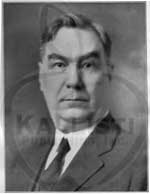 First and foremost, Haanel must be considered to have played a part in the New Thought Movement while certainly being influenced by that Movement. Several members of the Movement are quoted in his publications and the terminology used throughout his works seems to stem from this 19th century — primarily American — phenomenon. Between the publication of The Master Key System and The Amazing Secrets of the Yogi, Haanel became interested in religions other than the rather Christian-based New Thought Movement. What caused this interest, though, is anyone’s guess.
First and foremost, Haanel must be considered to have played a part in the New Thought Movement while certainly being influenced by that Movement. Several members of the Movement are quoted in his publications and the terminology used throughout his works seems to stem from this 19th century — primarily American — phenomenon. Between the publication of The Master Key System and The Amazing Secrets of the Yogi, Haanel became interested in religions other than the rather Christian-based New Thought Movement. What caused this interest, though, is anyone’s guess.
(top)
The Final Analysis?
The only description of Charles F. Haanel the man is from Walter B. Stevens.
“He is a man of mature judgment, capable of taking a calm survey of life and correctly valuing its opportunities, its possibilities, its demands and obligations. He has wisely sought success along the lines of least resistance and yet when difficulties and obstacles have confronted him he has displayed a force of character that has enabled him to overcome them and continue on the pathway to prosperity. Many a man whose life is one of untiring industry does not win success for he lacks the complement to industry a laudable ambition which prompts the individual to reach out into other fields and eagerly grasp the opportunities that are presented. In these qualities Mr. Haanel is richly endowed and has thus attained his present enviable position in financial circles.”
Any other information about Haanel the man has proven to be unobtainable. The closest relatives that were able to be interviewed were great-nieces and -nephews. One great-nephew remembered visiting his “crazy uncle Charlie’s” house and remembered him as being a nice old man, but nothing further.
It should also be noted that for someone who created a significant amount of wealth in his lifetime, there appears to have been no great estate that was passed after Mr. Haanel died. While it appears that Haanel was not poor when he died, it also does not appear that he lived a “millionaire lifestyle.”
It has been posited by some (although there are no references) that Haanel was not writing or publishing in the years preceding his death. It appears that Haanel’s last book was The Amazing Secrets of the Yogi (1937). From 1937 until his death in 1949, what did he do? Some have posited that he simply retired. Others have theorized that he became sick and therefore retired for health reasons. Until further information can be obtained, the answer will remain a mystery.
In many ways, Haanel was a man ahead of his time. His perennial tome The Master Key System successfully combined various philosophies and teachings into an accessible volume for the every-man describing a complete method of success. This book was not only successful in his day, but was very influential for future self-help legends, such as Claude M. Bristol (author ofThe Magic of Believing) and Napoleon Hill (author of Think & Grow Rich).
Haanel proved to be more visionary in his later writing as he explored various religious experiences, Eastern philosophy, and Biblical interpretation, as well as sundry explorations into psychology, theology, and the sciences.
His methods of marketing from the “correspondence course” to the sundry pamphlets and brochures he used prove him to have been an astute businessman. The methods he used — and perhaps innovated — are still used today with great success.
The world is a richer place because Charles F. Haanel was in it — not only because of the books he wrote and published that exist over fifty years after his death, but because of the life he lead and the example he set. Of all the authors in the self-help genre, Haanel was a person who not only talked the talk, he also walked the walk.
(top)
History of the Haanel and Fox Families and Other Family Members
For a detailed history and genealogy of the Haanel and Fax families as well as a biography of Charles F. Haanel’s uncle Eugene Haanel and his family, please see the following links.
History of the Haanel and Fox Families
Walter B. Stevens’ Biography of Haanel from St. Louis — History of the Fourth City
(top)
Footnotes
(1) Haanel’s death certificate states he was born in Lansing, Ingham County, Michigan. (back)
 (2) On p. 246 of The Book of St. Louisans: a biographical dictionary of leading living men of the city of St. Louis and vicinity (1906), it is stated that Haanel began work at the National Enameling and Stamping Company in 1886 and “remained with that company until Oct., 1904, when he took present position as president of the Continental Commercial Co., wholesale sugars and coffee.” While Walter B. Stevens wrote “He initiated himself into the business world as an office boy for the National Enameling and Stamping Company.” Directories, however, show that Haanel was connected with publishing in 1890 and 1895 and that he was secretary of the Oaxaca Coffee Culture Company in 1901. (back)
(2) On p. 246 of The Book of St. Louisans: a biographical dictionary of leading living men of the city of St. Louis and vicinity (1906), it is stated that Haanel began work at the National Enameling and Stamping Company in 1886 and “remained with that company until Oct., 1904, when he took present position as president of the Continental Commercial Co., wholesale sugars and coffee.” While Walter B. Stevens wrote “He initiated himself into the business world as an office boy for the National Enameling and Stamping Company.” Directories, however, show that Haanel was connected with publishing in 1890 and 1895 and that he was secretary of the Oaxaca Coffee Culture Company in 1901. (back)
(3) His full name was Charles Henry McKee. He was vice-president of the Globe Democrat newspaper at the time and later president and editor of the newspaper. He died on December 19th 1918, aged 65. (back)
(4) According to Gould’s St. Louis Red Book, the Continental Commercial Company was still trading with Hennings as president and McKee as vice-president in 1914. There is no mention of Haanel, but a 1905 directory certainly has him listed as president of this company. (back)
(5) As for Charles’ other children, Jennie had married Charles Frees of St. Louis in 1915. Beverley married Chester Hawke and went to live in San Marino, California. Charles, Jr. joined the US Army Air Corps in 1941 and died following an automobile accident on April 2, 1942. Esther and Walter remain partial mysteries. Walter is recorded as having died in California in 1967. He is not mentioned in Charles F. Haanel’s obituary, so it is possible they had become estranged. Esther was a teacher at the Devonshire School and living with her parents in 1918. In 1920 she was still with Charles and Margaret at 5032 Cabanne Avenue, St. Louis, and still a teacher, but no further references for her after this date could be found. (back)
(6) Today it is known as The Rosicrucian Digest. (back)
(top)
Sources
A listing of sources used in researching this biography of Charles F. Haanel and the Haanel family can be found here.
(top)

